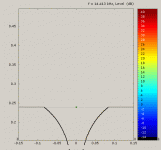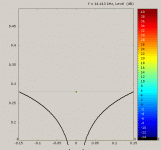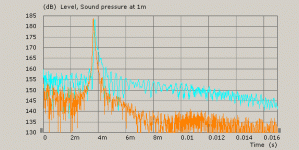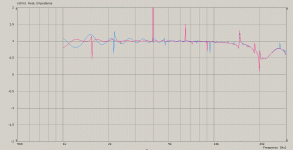That ETC is a new one for me. Thanks
Aren't we seeing stored energy in the smears on the spectrograms?
Aren't we seeing stored energy in the smears on the spectrograms?
Aren't we seeing stored energy in the smears on the spectrograms?
Good question?? Some maybe some maybe not. I think the more important question is how do we quantify what we see in the CSD/ETC with audibility. If you can't hear the smears or their effects then they are of little importance. I don't know where the threshold lies and if what we see in our CSD scans is of real significance. Obviously the "cleaner" the better but when does it become not clean enough??
Rob🙂
I have some measurement data, but more simulation. But no compression drivers in the lot. Cross comparing simulation of measured devices and trying to figure out what next to build. Normally, simulation/analysis is used to provide a reasonable estimation of what factors will effect a design so that whenever a test article is built, it will be closer to what is desired.You are seeing stored energy in Compression drivers and horns?? Any real data or just simulations??
Rob🙂
Generally, faster decay corresponds with less stored energy.What does stored energy look like in the CSD?
Generally, faster decay corresponds with less stored energy.
I thought the Linkwitz site had a useful demonstration of that on it.
Issues in speaker design - 2
Dan
I thought the Linkwitz site had a useful demonstration of that on it.
Thanks for linking that. I didn't know about it.
Cross comparing simulation of measured devices and trying to figure out what next to build.
Well we all seem to be doing that to one degree or another. Best part is definately building it.
Rob🙂
Yes. That is part of the information that inspired me to look into this issue. The purpose of looking at this kind of data from various perspectives is to understand the where the energy is stored in order to find an improvement solution. This part is probably the most tricky part, and requires deep understanding of interaction between various parts of the speaker.I thought the Linkwitz site had a useful demonstration of that on it.
Issues in speaker design - 2
Dan
Yes. That is part of the information that inspired me to look into this issue. The purpose of looking at this kind of data from various perspectives is to understand the where the energy is stored in order to find an improvement solution. This part is probably the most tricky part, and requires deep understanding of interaction between various parts of the speaker.
Ha ha! Too many darned tricky parts!
In some cases outer part of the horn has significant effect on stored energy, but smoother acoustic impedance may not reduce stored energy. One example shows horns of basically the same curve except one is extented the lip section outward making is longer. Resulting in more stored energy, smoothed acoustic impedance.
Attachments
Thanks. There seems much to be learned.
In the Newell and Holland book on loudspeakers, it mentions smooth acoustic impedance is an important factor. In my experience, stored enegy plays an important factor in how clean the sound reproduction will be. Now looking at these sims, it seems acoustic impedance is more related with efficiency of the system, and probably has less to do with any honk or HOMs than I originally thought.
In the Newell and Holland book on loudspeakers, it mentions smooth acoustic impedance is an important factor. In my experience, stored enegy plays an important factor in how clean the sound reproduction will be. Now looking at these sims, it seems acoustic impedance is more related with efficiency of the system, and probably has less to do with any honk or HOMs than I originally thought.
Hi,
It took a while but here's some wavelets of the JBL2431H in RCA MI9594 horn.
Here's a multiresolution wavelet from 500Hz-20kHz up to 20ms. The right hand side is normalised to 0dB at every frequency.
And here's 'conventional' wavelet:
And here's the same but from 1kHz-20kHz up to 10ms:
There is two long resonances, at about 7.5kHz and 15kHz.
Before 2ms there is two strong reflections. Interesting would be to know if the reflection at 3ms is from the horn or the room?
Where is the honk in this horn?
In this big horn throat-mouth-throat distance is about 1.5m and thus it takes about 4.3ms for a mouth reflection. But there is nothing much seen at 4.3ms??
It might be needed to measure this horn outside without room reflections to separate the honk from the room? Have the snow melted yet? 😛
- Elias
It took a while but here's some wavelets of the JBL2431H in RCA MI9594 horn.
Here's a multiresolution wavelet from 500Hz-20kHz up to 20ms. The right hand side is normalised to 0dB at every frequency.
An externally hosted image should be here but it was not working when we last tested it.
And here's 'conventional' wavelet:
An externally hosted image should be here but it was not working when we last tested it.
And here's the same but from 1kHz-20kHz up to 10ms:
An externally hosted image should be here but it was not working when we last tested it.
An externally hosted image should be here but it was not working when we last tested it.
There is two long resonances, at about 7.5kHz and 15kHz.
Before 2ms there is two strong reflections. Interesting would be to know if the reflection at 3ms is from the horn or the room?
Where is the honk in this horn?
In this big horn throat-mouth-throat distance is about 1.5m and thus it takes about 4.3ms for a mouth reflection. But there is nothing much seen at 4.3ms??
It might be needed to measure this horn outside without room reflections to separate the honk from the room? Have the snow melted yet? 😛
- Elias
...
- The horn is a huge old RCA 60 degree radial / similar to the Altec 311-60 ( minus the mouth vanes ) .
- Rough dimensions of the horn are ;
- Mouth ; 13H x 24.5W ( 33cm x @ 62.23 cm )
- Depth ( to driver ) @ 29" ( 73.66 cm )
- Depth ( to diaphragm ) @ 30" ( 76.2 cm )
...
ps ; heres the ARTA file zipped .
It might be needed to measure this horn outside without room reflections to separate the honk from the room?
Or use the impedance curve.
Simple and effective.
Or use the impedance curve.
Simple and effective.
Does a room reflection show up in the impedance in your tube method?
- Elias
Does a room reflection show up in the impedance in your tube method?
- Elias
Probably, but very lesser than horn reflection.
I was talking about impedance even without tube, for wavelet.
The tube has other advantages
could we possibly do a wavelet correlation between the two methods ?
We would need from the same horn both, the acoustic and the impedance measurement.
Also - I was thinking about doing some measurements right at the throat for comparison.
This should have further benefit in diminishing room interaction. With all the wavelet software checking and also some basic coding I haven't had time to do myself - but its definitely on my list...
Michael
We would need from the same horn both, the acoustic and the impedance measurement.
Also - I was thinking about doing some measurements right at the throat for comparison.
This should have further benefit in diminishing room interaction. With all the wavelet software checking and also some basic coding I haven't had time to do myself - but its definitely on my list...
Michael
Last edited:
Well I don't know, but what I see in those wavelet graphs is mostly junk between 1-3KHz.
That's where it is the messiest. And in the freq. range, it should be very easy to hear.
That's where it is the messiest. And in the freq. range, it should be very easy to hear.
If "honk" is down near cutoff, there is certainly trouble just below 4ms.Where is the honk in this horn?
In this big horn throat-mouth-throat distance is about 1.5m and thus it takes about 4.3ms for a mouth reflection. But there is nothing much seen at 4.3ms??
The stuff up top is something other than honk, by this view.
If "honk" is down near cutoff, there is certainly trouble just below 4ms.
The stuff up top is something other than honk, by this view.
Not entirely.
You can see periodic resonances that travel up from the primary "mouth" resonance.
What you can't see is how the entire output is modulated by the mouth resonance - i.e. freq. response "ripple" at the average. (.."average" meaning full-output.) In this respect (and generally), I prefer a well-scaled series of CSD plots at varying axis's.
- Status
- Not open for further replies.
- Home
- Loudspeakers
- Multi-Way
- Horn Honk $$ WANTED $$



